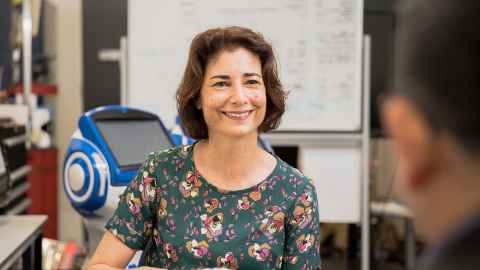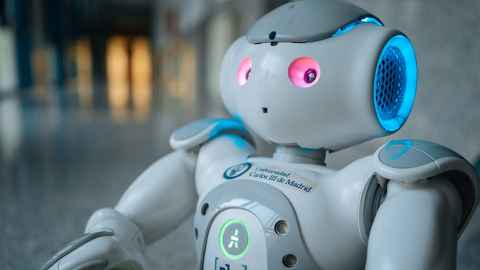Can you trust a robot?
21 April 2020
Robot caregivers can help maintain independence as we age, but the trick is getting humans to trust them.




It will not surprise those with a pessimistic view of humanity to know that even robots suffer racial prejudice.
In a study by German researchers participants were asked to rate a robot with a German name, said to be developed in Germany, and a robot with a Turkish name, they were told was built in Turkey. The participants felt warmer towards the German robot, described it as better designed and with greater ability to experience the world. The robots were identical.
The study shows why Elizabeth Broadbent, the Professor of Psychology at the Faculty of Health and Medical Sciences at the University of Auckland, finds robots a rich source of insight into human behaviour, emotion and thought. If a randomised controlled trial is the gold standard for science, researchers studying human behaviour face the puzzle of how to control the countless complicated variables that govern our behaviour.
A scientific study of prejudice faces countless variables: from ethnicity, accent and attractiveness to height and weight, all of which could affect results. If you tell someone to rate a robot based on whether it is German or Turkish, that’s the only variable.
Elizabeth trained as an electrical engineer and went on to work with a company that created a series of virtual reality rides for Te Papa in the 1990s. They figured out how to give visitors the experience of shearing a sheep or even more impressively, riding a whale. She has always wanted to make humanlike robots and that led her to return to university to study psychology to gain a better understanding of how the human brain works.
She now combines both disciplines, working with gerontologists, engineers and robotics manufacturers to turn clunky automatons into friendly robot companions. For the elder and health care sectors, the robots aren’t coming, they’re already here while in the broader sense Elizabeth’s research asks the questions about how we will live with robots, for better or worse.
"One of the things we trying to do is see how a robot shows that it's paying attention to you and how does it appear friendly and understanding.”
The trick is to make robots behave in more lifelike ways. Patients expect robots to care, which means they need to adopt the verbal and non-verbal cues for empathy. One project Elizabeth is working on is how to develop a robot receptionist for a health clinic.
She says,” Receptionists in clinics have quite complicated interactions with patients. People come in feeling horrible and vulnerable. One of the things we trying to do is see how a robot shows that it's paying attention to you and how does it appear friendly and understanding.”
A second major project with a number of Korean universities wants to know if a companion robot able to play memory games and assist with daily living will help people living with dementia remain in their own homes.
The memory games may reduce cognitive decline and the robot can also lift the burden for human caregivers and relatives by giving reminders about ovens left on, front doors unlocked and forgotten meds. The simple act of being able to respond to often repeated questions from dementia sufferers about what day it is and where they are will relieve their anxiety and help them to feel happier.
South Korea, like New Zealand, has an ageing population and rising numbers of people diagnosed with dementia. Here, estimates are that by 2030, 102,015 New Zealanders will experience dementia, or about double the present population of a city like Invercargill, rising to more than 170,000 people by 2050. In healthcare dollars that’s about $4.6 billion.
Human looking robots
The most successful health care robot Paro doesn’t even have legs. Paro, whose inventor Professor Takanori Shibata won the $250,000 2018 Ryman Prize, an international award for advancing the health care of older people, is a cute seal, a robot pet that never needs feeding, always responds to patting and as a companion robot animal has been proven to lift mood, reduce anxiety and decrease loneliness.
Elizabeth has trialled Paro with elderly residents in Selwyn Retirement Villages. “Some people seemed to respond to Paro more than they would with humans. Sometimes people with dementia aren't interested in talking to people but are happy to talk to the robot and really love it.”
To date more than 5000 Paros have been sold. While Paro is a success, the real breakthroughs will be with humanlike robots. As Elizabeth says, “Robots, especially those in health care, are better accepted if they look human.”
She knows because she tested it, using three different robot avatars for the PeopleBot robot, used to help people take their blood pressure. The PeopleBot had three ‘faces’, one with human features, another with a silver android and blank eyes and one with no facial features at all. People found the ‘human face’ friendly, helpful and patient. Some rated it ‘affectionate’. The robot with the silver android face was seen as practical but potentially ‘creepy; while the first ‘face' the blank was impersonal and ‘soul-less’.
Robot family tree
Android: a robot with a human appearance but not that of a specific individual
Geminoid: A tele operated robot that is built to resemble a specific human individual
Wizard of Oz: a situation in which people interact with a robot that they think is autonomous but that is secretly being operated by another person
Telenoid: a tele operated robot designed to have minimal characteristics of a human, usually ageless, and genderless with ahead, torso and short limbs.
Source: Interactions with Robots: The Truths We Reveal About Ourselves, Elizabeth Broadbent, Annual Review of Psychology, 2017.
Better healthcare
What would the ideal healthcare robot look like? Elizabeth has published a paper that describes the attributes needed for a robot to communicate with a patient based on what we know works best between doctor and patient.
Along with givens, like patient confidentiality and doing no harm, a better healthcare robot would be one that uses the patient’s name, makes eye contact and encourages a patient to tell the wider story of their situation.
That ideal robot would need to be able to offer clear information about disease, treatment and tests, but also work with the patient towards shared decision-making. This robot would never call in sick and be on call 24/7.
Elizabeth notes in the paper: “While the principles of good doctor-patient communication are known, not all physicians apply them well. An advantage of healthcare robots is that they can be programmed to regularly apply these rules.”
Elizabeth works with robots every day and knows what they can and cannot do. She rejects the view that robots will take jobs, especially in the health care sector. She attends conferences and symposia on Artificial Intelligence and Robotics in health care. She says:“The doctors there are always asking how they can get hold of this technology.”
They want to improve the accuracy and consistency of diagnosis and prognosis of disease and disorder. The robots will free up time so health care providers can spend better quality time with patients.
Patients improve
Elizabeth and a team of University of Auckland researchers worked with clinicians at Middlemore Hospital to see if a robot companion with a group of patients with Chronic Obstructive Pulmonary Disease (COPD) would help the patients take their medicine properly and do regular rehab exercises.
After a four-month trial, the patients with robots were doing better in terms of medication and exercises, and while hospital admissions remained the same, the patients with robots spent less time in hospital. Allowing for the cost of hospitalisation, an investment in companion robots, would return 112 per cent of every health dollar spent.
Story by Gilbert Wong
Researcher portrait by Billy Wong
The Challenge is a continuing series from the University of Auckland about
how our researchers are helping to tackle some of the world's biggest challenges.
To republish this article please contact: gilbert.wong@auckland.ac.nz